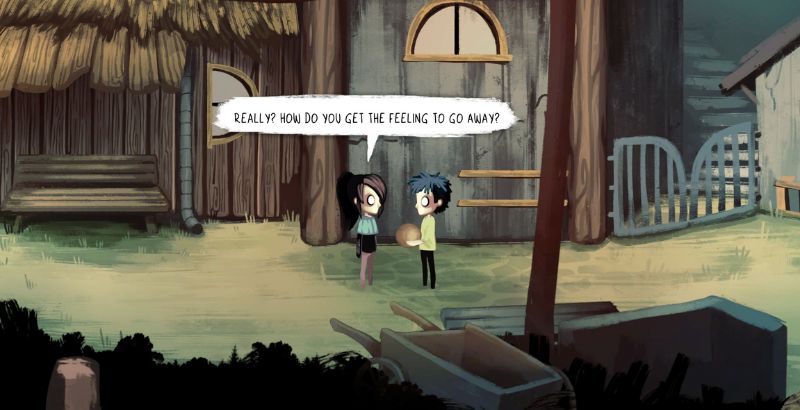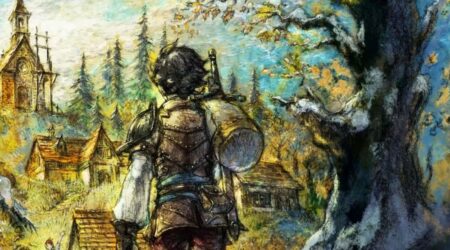
Children of Silentown is a point-and-click adventure game published by Daedalic Entertainment. Making its first appearance on November 25, 2020, with a playable demo, Children of Silentown: Prologue, was very well received by its audiences. This inspired the developing teams Elf Games and Luna2 Studio to turn, what was their original intention, a small project into a more fleshed-out one—expanding on its characters and world-building.
With rays of warmth reaching in, entering through a deep forest of dusty, faded shades of purples and reds to find a small village called Silentown. It’s a quiet little area with a small population—the kind of village where everyone knows each other. Cracked concrete walls and flooded pipelines show their age and state, often held together by the villagers’ efforts. Life seems… simple. Easy. Quiet. Maybe too quiet?
The village bell tolls as day becomes night. All that was once a glimmer of warmth and life now becomes sullen with hues of grey and blues. It is silent.
In Children of Silentown, we play as a young girl named Lucy living in Silentown with her parents and a black cat named Squinty. Lucy is noticeably striking: barren and expressionless, with only enlarged eyes of white dominating her form. A very intentional character design choice echoed across all villagers, complimenting the tone and mood of the Silentown. Cute and creepy. Players learn early on the village is nestled in a vast forest inhabited by monsters, and life in Silentown is quiet for a reason that isn’t quite explained just yet. Haunted by reoccurring thoughts and dreams, Lucy decides to investigate the mysteries and secrets kept from the children of Silentown.
As a point-and-click, dialogue and story are vital. Dialogue options sometimes appear for players to personalize their interactions with others, and few seem to hold different outcomes. The exchanges held between the adults and children are withholding and carry the dated mentality that the youth shouldn’t know the things adults do. Specific to the happenings in the village. This exclusion adds to the isolation one might feel as a kid, feeling like they are old enough to access such information.
Classically, most point-and-click adventure games focus on finding items and combing them at the right time. Children of Silentown does this while also pulling inspiration from other adventure games. Shifting the camera view allows players to roam more freely in the world rather than linearly. Some quest-like structures like finding stickers for Lucy’s diary are added to connect the player to the world and its characters.
Progression is built around solving puzzles in the world and through mini-games that directly relate to the story. Need to find tea for your unannounced guest? Queue a jigsaw puzzle mini-game because it’s a mess in the drawer. Want some intel on town rumors from the other kids? Only if you win in a frog versus hedgehog race. The game does a good job at gradually integrating new concepts or tools into its existing ones, keeping it from being too repetitive. Ultimately, Children of Silentown successfully kept me engaged as the story progressed. Mixing lighthearted fun with some more complex pieces.
Additionally, music holds an important symbolism throughout the game. As Lucy, you acquire notes throughout the world to create melodies. Once a melody is created, it can be used to “evoke spontaneous, sincere thoughts in people,” which helps with game progression and story building. This is a core mechanic the player unlocks as it ties to Lucy’s musical relationship with her mother. It allows players to see what others are feeling and thinking. It embodies gentleness and understanding for those around you. Each song is a themed specific mini-game, creating more variety and complexity for the title. Every time a melody was heard, I couldn’t help but feel the environment get a little brighter, the only gleam of an uplifting, positive force in the village.

At more than halfway through the game, it never felt too challenging or too simple. Even when I got devastatingly stuck on a world puzzle. I found myself combing through every part of the environment with my mouse and forcefully trying to combine items that I knew wouldn’t work for the twentieth time. That quiet, simmering desperation for progress sets in, but I knew it was attainable because the puzzles were logical in presentation. Whether it was my own hang-up or a bug that served as a barrier, I still had a great time with the game. In my unstuck moments, it was rewarding to solve new iterations and motivating to see how the story continues to unfold. I did not finish this game due to hitting a wall, but I highly enjoyed the pacing and the mystery it carries.
With an art style clearly inspired by Tim Burton and Henry Selick, namely Coraline for the latter, the faded cool and warm tones blend seamlessly well with the somber piano keys heard throughout your exploration of the village. Children of Silentown sinks you into a world that is eerily beautiful. It holds you, not knowing what the night brings or what lurks in the forest – and that’s a good thing.
Children of Silentown is available now on Nintendo Switch and PC via Steam.
Children of Silentown
-
Rating - 8/108/10
TL;DR
Children of Silentown sinks you into a world that is eerily beautiful. It holds you, not knowing what the night brings or what lurks in the forest – and that’s a good thing.







